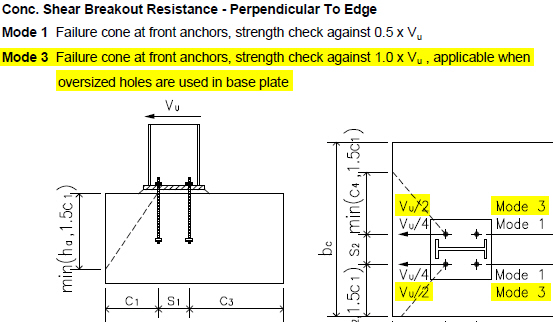This is the second option input user needs to make an engineering
judgment regarding the oversized bolt hole and it's impact on anchor
bolt's shear capacity.
The previous input, consider only half of total anchor bolt carrying
shear due to oversize bolt hole Y/N, is for anchor bolt material shear
capacity calc. If Yes is selected, only half of the anchor bolt is used to
calculate anchor bolt material shear resistance.
This input, oversized holes in base plate Y/N, is for anchor bolt
concrete shear breakout calc. If Yes is selected, when checking front
anchor conc shear breakout, front anchors will take 100% Vu for
checking due to the oversized bolt hole. This mode is different from
the common sense that front anchors take 50% Vu and back anchors
take another 50% Vu , this mode requires that there is no oversized
bolt hole so that the shear can be distributed equally to every anchor
bolt in the bolt group.
Oversize hole Yes ⇨ Mode 3 is used ⇨ front anchors take
1.0 x Vu shear force
Oversize hole No ⇨ Mode 1 is used ⇨ front anchors take
0.5 x Vu shear force
If select Yes ,this means significant oversized holes are used in the
column base plate.
In concrete shear breakout check, Mode 3 is used for checking,
front anchors take 1.0 x Vu shear force. (Reference: ACI 349.2R-07
Guide to the Concrete Capacity Design (CCD) Method-Embedment
Design Examples Page 47)
If select No , this means special provisions are made to equalize
the shear force transfer from base plate to all anchor rods.
In concrete shear breakout check, Mode 1 is used for checking,
front anchors take 0.5 x Vu shear force
Select No if anchor bolt plate washers are tack welded to base plate
and anchor bolt nuts.
